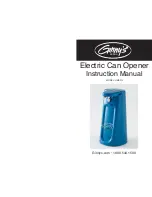
22
16 - WIRING AND CONNECTIONS
Permanent wiring is to be employed for the installation as required by
local codes.
Use only U.L. listed (or equivalent) non-contact sensors. Inputs from the
photo-beam to the circuit board are Normally Open (N.O.). Use only U.L.
listed (or equivalent) non-contact sensors.
Connect the non-contact sensors. Inputs from the photo-beam to the circuit
board are Normally Open (N.O.). Photo-beam input shall REVERSE travel
of gate when activated during the CLOSE CYCLE ONLY. Gate will resume
normal operation when photo-beam is no longer activated.
To reduce the risk of SEVERE INJURY or DEATH;
• Disconnect power to the gate operator by manually opening its dedicated
circuit breaker before making any mechanical or electrical adjustments.
• Use a 20 Amp dedicated circuit breaker for each installed gate operator.
• Open dedicated circuit breaker supplying power to this gate operator
BEFORE a new installation or making any modifications to an existing
installation of this gate operator.
• All wiring connections MUST be made by a qualified individual.
• Run individual circuits in separate U.L. listed conduits. Do not combine
high voltage (120VAC) power wiring and low voltage (+12VDC to +24VDC)
control wiring in the same conduits.
• It is highly recommended that a grounding rod be installed with each
operator according to local building codes to provide protection against
near lightning strikes. Contact local underground utility companies
BEFORE digging.
• Use the information in Table 1 to determine high voltage wire size
requirements. The distance shown in the chart is measured in feet from the
operator to the power source. If power wiring is greater than the maximum
distance shown, it is recommended that a service feeder be installed.
When large gauge wire is used, a separate junction box must be installed
for the operator connection. The wire table is based on stranded copper
wire. Wire run calculations are based on a 110 VAC power source with a
3% voltage drop on the power line, plus an additional 10% reduction in
distance to allow for other losses in the system.
Table 1 - Wire Gauges and Maximum Power Circuit Distances
110V
AWG
14 12
10 8 6 4
MAX RUN (ft)
180
280
460
700
1150
1800
Figure 19 - GROUNDING WIRE
The gate operator should be grounded to a copper rod driven to a
minimum depth of 3 feet, and properly grounded to the opener using a
¼” copper wire prior to operation. Ensure proper ground bonding by
removing paint around the mounting hole to create a proper connection if
required. (Burnishing may be required) Check conductivity using a multimeter
to verify bonding. (Ring-Out). See figure 19.
WARNING
This swing gate operator uses an inherent entrapment sensing system as well
as external type sensors.
WARNING: External entrapment protection must be added to insure a
safe vehicular gate operating system.
Entrapment protection must be provided by a combination of non-contact
inherent devices. Disconnect power to the gate operator before installing the
non-contact sensors.
Actual placement of sensors is dependent on the specific installation
requirements.
One or more non-contact sensors should be located where the risk of
entrapment or obstruction exists such as the perimeter reachable by a
moving gate or barrier
ISOLATE ALL ELECTRICITY PRIOR TO INSTALLATION OR SERVICE
Deleting All Nice Remote Controls from the Nice Plug-In Receiver
Memory.
All programmed remote controls may be removed from the SMXI/A plug in
receiver memory . This procedures need to be performed at the gate controller.
1.
Press and hold the button on the side of the SMXI/A receiver until the led
on the SMXI/A receiver illuminates green and keep the button pressed.
2.
Watch the led and on the receiver and verify the following sequence in the
led.
3.
Within 4 seconds after pressing the button (approx.) the green led
illuminates.
4.
Within 8 seconds after pressing the button (approx.) the green led turns off.
5.
With 12 second after pressing the button (approx.) the green led starts
flashing.
6.
Count the green led flashes on the SMXI/A receiver. On
EXACTLY the 5
TH
flash, release the button on the SMXI/A receiver.
7.
It is recommended to test the FloR/A remote controls, if available, with
SMXI/A plug in receiver to verify that it no longer affects the gate controller.
15 - ACCESSORY INPUTS AND OUTPUTS (CONT.)
16 - WIRING AND CONNECTIONS (CONT.)
Summary of Contents for Apollo 4300SW
Page 2: ......
Page 40: ...38 35 GATE ARM INSTALLATION Figure 33 CORRECT LAYOUT INCORRECT INSTALLATION Figure 34...
Page 44: ......
Page 45: ......
















































